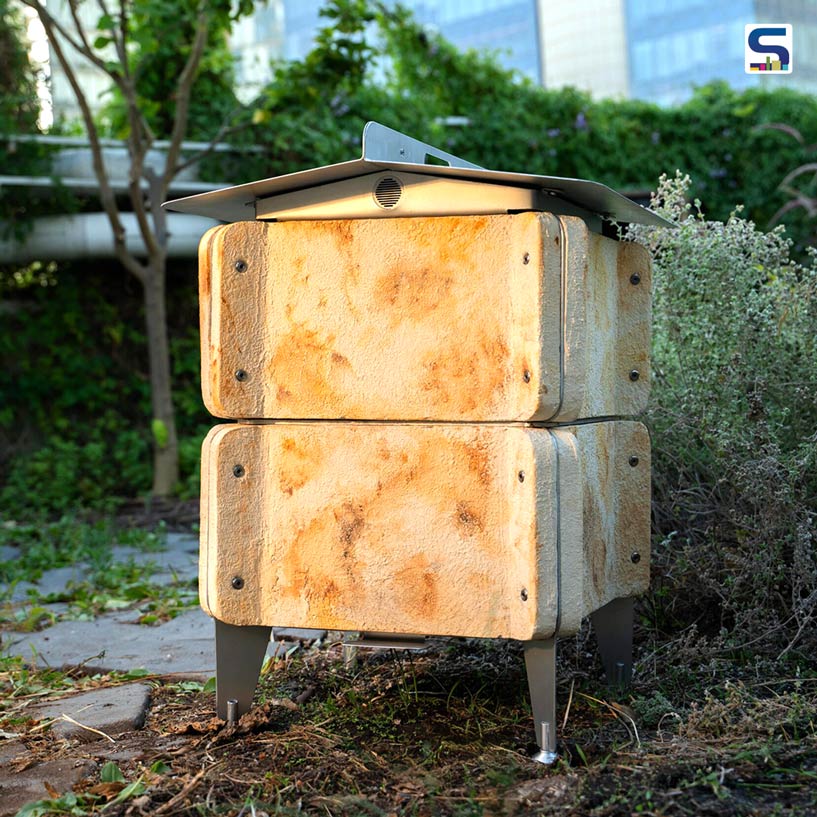
The Bee2C project has offered a groundbreaking rethinking of how design and ecology can merge to create solutions that are both functional and regenerative. At its core is a modular beehive that combines mycelium grown on recycled coffee grounds with an aluminium frame, producing a habitat that not only supports pollinator health but also demonstrates the power of circular design. By turning organic waste into a durable construction material, know on SURFACES REPORTER (SR) how Bee2C reshapes the concept around sustainability, material innovation and our relationship with nature.

At its core is a modular beehive that combines mycelium grown on recycled coffee grounds with an aluminium frame, producing a habitat that not only supports pollinator health but also demonstrates the power of circular design.
Design meets ecology
Every Bee2C hive makes a measurable difference. According to its creators, each unit saves 450kg of CO2 annually. This environmental performance stems directly from its material choices with the use of 100 per cent upcycled inputs and a design that closes the loop between waste generation and ecological renewal. The aluminium parts can be reused indefinitely, while the mycelium, once the hive reaches the end of its lifecycle, decomposes back into the soil, returning nutrients to the earth.

The process of creating these hives begins with cultivating mycelium on a substrate of recycled coffee residues.
The process of creating these hives begins with cultivating mycelium on a substrate of recycled coffee residues. These include materials that would otherwise end up as waste such as used coffee grounds, roasting byproducts and agricultural fibres. The resulting bio-composite is remarkable for its qualities as it offers natural antibacterial resistance, excellent thermal insulation and structural stability. Equally important, it is fully biodegradable, aligning perfectly with the principles of a circular economy.
Circular design at work
When compared to traditional beehive materials, the advantages of Bee2C become even clearer. Conventional hives are typically made from pine wood or expanded polystyrene (EPS). While pine is durable and familiar to beekeepers, it depends on forestry resources and provides limited thermal insulation. EPS, on the other hand, is lightweight and insulating, but its environmental impact is troubling as it breaks down into harmful microplastics, lacks durability and is difficult to recycle.

To ensure functionality and long-term performance, the design integrates mycelium panels with an aluminium frame.
To ensure functionality and long-term performance, the design integrates mycelium panels with an aluminium frame. This hybrid approach brings together the best of aluminium which provides structural strength and resilience against outdoor conditions, while mycelium delivers insulation and breathability essential for bee health. Aluminium was chosen intentionally for its ability to withstand decades of exposure and for being infinitely recyclable. The mycelium panels are compression-moulded to maintain consistency, ensuring that each hive meets practical standards for use in varied environments.

EPS, on the other hand, is lightweight and insulating, but its environmental impact is troubling as it breaks down into harmful microplastics, lacks durability and is difficult to recycle.
The modular nature of the design enhances its appeal. The hives can be flat-packed, easily assembled and scaled cost-effectively, making them accessible to both professional apiarists and amateur beekeepers. This adaptability opens the door for wide applications, right from urban rooftop beekeeping initiatives to rural agricultural projects and community-led biodiversity programs.
Image credit: Material District for Bee2C project